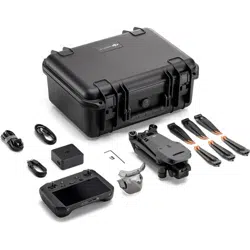Loading ...
Loading ...
Loading ...

DJI Mavic 3E/3T User Manual
82
©
2022 DJI All Rights Reserved.
2. After setting the task name and selecting the camera to collect aerial photogrammetry
data, set the following flight route parameters in sequence:
a. Set the altitude mode (ASL/ALT), flight route altitude, takeoff speed, flight route
speed, course angle, the action upon completion, and enable elevation optimization.
b. In Advanced Settings, set the side overlap ratio, frontal overlap ratio, margin, and
photo mode.
3. Tap
to save the task and tap to upload and execute the flight task.
4. Power off the aircraft after the task is completed. Remove the microSD card from the
aircraft, and connect it to the computer to check the taken photos and the generated
files.
• When using mapping, oblique, and linear tasks, the default camera focus mode is MF
infinity, and the distortion correction is disabled.
• During an orthophoto operation, it is recommended to adjust the flight route speed to
the maximum value and enable elevation optimization.
The route parameters are described as follows:
Specifications Description
Altitude Mode
(ASL/ALT)
The starting plane of the flight route altitude.
•
Relative to Takeoff Point (ALT): the altitude of the aircraft relative
to the takeoff point. It is recommended to use this option for
aerial mapping operations. Then, Target Surface to Takeoff Point
will appear. Target Surface to Takeoff Point = the altitude of the
target surface - the altitude of the take-off point.
•
ASL (EGM96): the altitude of the aircraft relative to the EGM96
geoid. Flight Route to Target Surface will appear. Flight Route to
Target Surface = the altitude of the flight route - the altitude of
the target surface.
Takeoff Speed
After the aircraft takes off and reaches the flight route altitude, the
flight speed before entering the flight route. This speed is not the
vertical take-off speed of the aircraft. It is recommended to set it to
the maximum to improve operational efficiency.
Speed
The operating speed of the aircraft after entering the flight route.
This speed is related to the GSD and the frontal overlap ratio.
Course Angle
The route angle can be adjusted, and the starting and ending
positions of the route will be adjusted accordingly. Note: the
estimated time of the task varies for different course angles. By
adjusting the course angle, the task with the shortest estimated time
can be planned to improve the operation efficiency.
Loading ...
Loading ...
Loading ...
